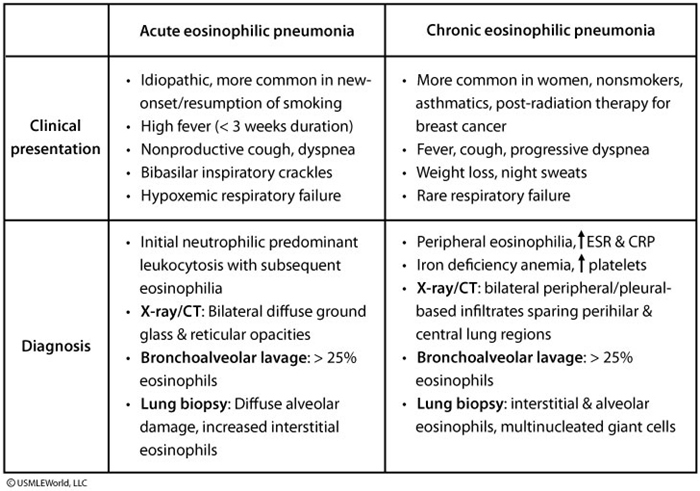acute and chronic eosinophilic pneumonia AEP and CEP
- related: Pulmonary Diseases
- tags: #literature #pulmonology

Idiopathic AEP is a severe illness of acute onset characterized by hypoxemia and respiratory failure. AEP is a disease affecting mostly young to middle-aged patients (average age, 29 years; range, 19-37 years) with a slight male predominance, and most patients are previously healthy. Forty to sixty-six percent of patients are smokers, and often recent onset smokers. In fact, cigarette smoking is the most commonly associated risk factor for AEP in those persons susceptible to its development. The patient may have recently increased tobacco use or resumed smoking after a period of discontinuation. Other associated risk factors with the development of AEP include heavy dust exposure, drugs, occupational exposures, and both World Trade Center dust and military exposures to sand and oil fields in the Middle East. Cocaine use has also been associated with AEP. An association with asthma is rare in contrast to chronic eosinophilic pneumonia (CEP).
Demographics and pathogenesis
Diagnosis
- diagnostic criteria for acute eosinophilic pneumonia
- AEP usually does not have peripheral eosinophilia
- acute eosinophilic pneumonia diagnosis include eosinophils on BAL, pulmonary infiltrate, febrile illness
- chronic eosinophilic pneumonia has more progressive onset and systemic symptoms
- eosinophilic pneumonia lung biopsy shows eosinophils, giant cells, bronchiolitis obliterans
Imaging
- acute eosinophilic pneumonia has ground glass opacitiees with consolidation on CT imaging
- chronic eosinophilic pneumonia has consolidation with peripheral predominance
Treatment
- treat eosinophilic pneumonia with steroids1
- Xolair for CEP
Links to this note
-
eosinophilia and lung disorders
- If a patient has recurrent hospitalizations for pneumonia, differential should include eosinophilic pneumonia (acute and chronic eosinophilic pneumonia AEP and CEP). Fever, cough, and abnormal chest xray are first clues. diagnostic criteria for acute eosinophilic pneumonia.
-
eosinophilic BAL points to atypical infections and atopic conditions
- eosinophil > 25% is diagnostic of acute and chronic eosinophilic pneumonia AEP and CEP
-
acute eosinophilic pneumonia has ground glass opacitiees with consolidation on CT imaging
-
chronic eosinophilic pneumonia has consolidation with peripheral predominance
-
acute eosinophilic pneumonia can present after unusual or unique exposures
-
chronic eosinophilic pneumonia has more progressive onset and systemic symptoms
-
eosinophilic pneumonia lung biopsy shows eosinophils, giant cells, bronchiolitis obliterans